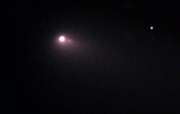A cracked comet

(�鶹��ԺOrg.com) -- A leading amateur astronomer has made a major astronomical discovery thanks to a sophisticated educational telescope project led by Cardiff University astronomers.
Amateur astronomer, Nick Howes, has taken the first pictures showing a split in the icy nucleus of Comet C2007 C3 using a remote-controlled telescope through the Faulkes Telescope Project based in the School of �鶹��Ժics and Astronomy.
The project offers access to a pair of remotely controlled telescopes, located on the Hawaiian island of Maui, and at Siding Spring in Australia - via the Internet.
Using the Faulkes Telescope North in Maui, Nick imaged the faint comet in glorious detail, producing a set of six images that showed a secondary condensation trailing the main nucleus. This appears to be a mountain-sized chunk of ice that has broken away from the giant “dirty snowball” that forms the nucleus of a comet.
A second set of images obtained the following day (Friday 19th March) clearly showed that the new fragment is still trailing the comet. It is now hoped that astronomers will follow up Nick’s discovery using instruments such as Hubble Space Telescope. Nick obtained the images whilst sat at his desk in work in Wiltshire, operating the £5M Hawaiian telescope over the Internet.
Dr Paul Roche, School of �鶹��Ժics and Astronomy, who is the Director of the Faulkes Telescope Project said: “We are delighted that Nick was able to capture dramatic images which appear to show that the comet’s nucleus is disintegrating.
“What this illustrates is what is achievable when amateur astronomers can get their hands on such a powerful telescope. We hope to involve schools in observing this comet over the next few weeks, so that we can see what happens to this new fragment.”
It’s hoped that this discovery will help encourage others to use the telescope for research and to help make new scientific discoveries. Last year, another amateur astronomer, working with several UK schools and the Faulkes Telescope Project, discovered the fastest-rotating asteroid in the Solar system.
More than 200 UK schools have used the telescopes to help in science lessons, often gathering data that is used by university researchers.
Dr Roche added: “As well as amateur astronomers this project allows researchers from the University to help schools access professional equipment, and learn more about how modern science is really done.
“We hope this discovery will help encourage others to use the Faulkes Telescopes and lead to even more scientific discoveries.”
The Faulkes Telescope Project was launched in March 2004 by the Dill Faulkes Educational Trust, as a way of helping to inspire school students to study science and maths.
Provided by Cardiff University
















